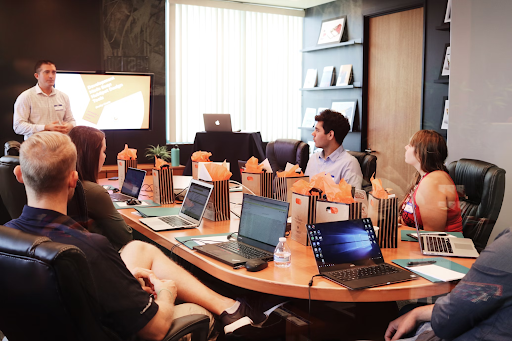
The future worker
We find ourselves in the second half of the second decade of the second millennium in recorded history. That's a lot of seconds. And how time flies. But we're also experiencing many firsts. The digital revolution has changed everything. How we live, communicate and interact with our surroundings and each other. How we enjoy ourselves, how we think, how we learn and most of all, how we work. Huge sweeping changes, the size and impact of which have probably not been witnessed since the industrial revolution.
For businesses and organisations of all sectors, these are times of unprecedented opportunity, and as we know when we experience change, there is an explicit need for fresh learning. To this end, Learning and Development providers supply such learning in the best way possible- by embracing the power and value of technology. Further, those providers know only too well that technology brings more than just solutions and answers to questions businesses already have, but also to problems not yet generally envisaged. Technology, clearly, is the answer.
But what questions are we addressing? What has changed? Well, in order to fully understand the power of technology in learning, we need to be aware of how we work, how we function and react, and what differences we've experienced during this revolution that can help us learn, help us develop.
So, what's changed about how we work?
Recent research carried out by Dell, finds that the workplace itself is being redefined and reimagined. As we increasingly depend on new technology, we become ever more transient and fluid in our approach to how we work, and importantly, to where we work. The traditional mode of desk based working still exists, with 43% of people spending more than half their working time at their desk. The size of this group will no doubt decrease over the coming years. At present, a little more than half of these desk based employees use a desktop PC and smartphone for their work.
The workplace now occupies less physical space than a decade or so ago, as a result of our increasing reliance on technology and the reshaping of our working lives. 19% of workers spend more than half their working time away from a desk, travelling to meetings, and are comfortable with working 'on-the-go' via tablets, smartphones and laptops/notebooks. This shows that the workplace is no longer the static entity of the past, but is a moving, transient, and global structure which needs to react to the changes it experiences.
A further 19% of employees work away from the office for more than half of their working time, travelling, and attending meetings off-site. This demographic is increasingly reliant on mobile devices, laptops and notebooks to work. With much of their work being carried out remotely, the ability for that technology to be fast, responsive and have better connectivity is clear. Access is all for this demographic as it is for our final group. A group whose ranks will inevitably swell in future.
Remote workers working 30hrs or more per week away from company buildings or the campus, are entirely reliant on laptops/notebooks and other devices for their work. Many people find that working remotely increases their productivity. They are able to better manage their time without distraction and to fit their work around other demands on their time, such as childcare, education etc. Senior managers are able to manage and assess this productivity, and communicate any ideas or developments, and this in turn helps the remote worker to further develop their skills.
So, we know that the working world is changing, and we must all prepare for these changes and fully immerse ourselves in developments. But how does this affect training? How do we keep employees fully onboard and updated with new ideas and structures within the company or organisation? How do we encourage their engagement and motivation if all employees are not all in one central place?
Digital learning platforms such as Wranx offer answers to all these questions and more. By relying on a combination of three important factors, Spaced Repetition, Gamification and Personalised Reporting, Wranx becomes a powerful and finely tuned tool for Learning and Development, bringing increased performance, time and cost efficiency, and productivity.
Spaced Repetition is a scientifically proven teaching method, based on the groundbreaking work of Hermann Ebbinghaus in the field of human memory and recall. Ebbinghaus identified that learning is better achieved when spaced out and delivered in smaller segments, rather than in one single session. By building the training around the method of Spaced Repetition, Wranx makes the learning both easier and faster in terms of engagement, a couple of minutes per day is all that's required. Users can engage with Wranx during the daily commute, in their own time, as and when they feel.
Gamification makes learning an enjoyable process and easy to engage with. Competition is a great motivator, encouraging and inspiring better performance. Progress is driven by the use of leaderboards, levels and rewards, and by recognising achievement. Users are rewarded for the level of their interaction, not simply for answering a question correctly.
Wranx uses Personalised Reporting, which gives companies and organisations the ability to monitor and provide ongoing feedback with access to real-time data analysis. L&D providers are able to track progress and users’ positions, along with their peers. This continual assessment allows Wranx increased flexibility while also creating a user-specific training experience. We find that this level of support drives commitment, engagement and productivity.
The key strength of Wranx is to be found in the combination and structure of these three important factors. It is more cost effective, easy to adopt and implement, and completely mobile, allowing access on a regular basis and at the initiative of the users.
So, as the workplace spreads out, so must the training. As the workplace becomes more defined around the ideas of mobility and connectivity, so must the training. And as companies and organisations begin to grow into this new world, so, inevitably, must the training.
This is the new future, and it's now.


